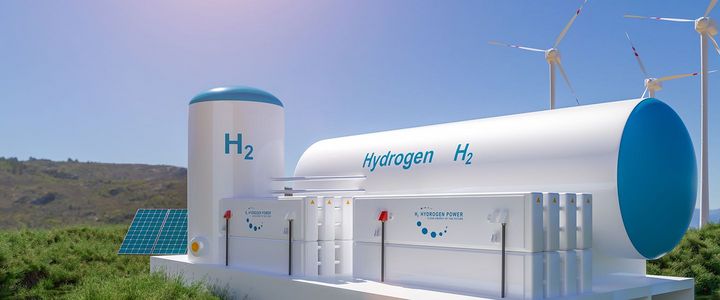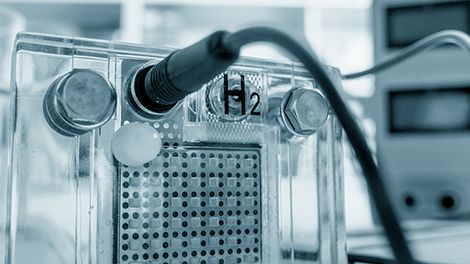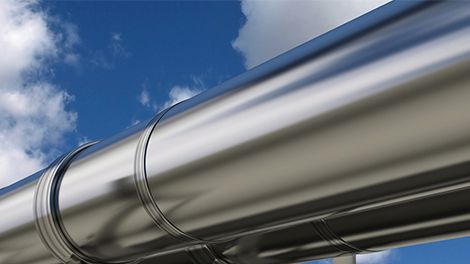Hydrogen production
Hydrogen (H2) is the most common element in the universe, present in very large quantities on Earth and contained in almost all organic compounds. At the same time, it only occurs in bound form - the best-known example of this is water (H2O), which consists of the elements oxygen (O2) and hydrogen. Since hydrogen is a secondary energy, primary energy is always required for hydrogen production. It can be used for the storage and transport of energy
The choice of primary energy determines whether the hydrogen in question is produced in an environmentally friendly way. By relying entirely on electricity from renewable energy sources, the end product is sustainable hydrogen. This is also called green hydrogen, because no carbon dioxide (CO2) is produced during its production. An overview of the different colour categories of hydrogen can be found below on this page. But how is hydrogen produced? If you want to produce hydrogen, you can resort to a number of processes: With regard to hydrogen production, the reforming process and water electrolysis are very well-engineered. The Kvæner process, hydrogen production from green algae and biohydrogen production are still undergoing trials.
Hydrogen is a topic with many facets - from production, transport and storage to use. With our expertise, know-how and many years of experience, we are an independent partner for safety and security by being able to test, inspect and certify various aspects of hydrogen technology.
Producing hydrogen with the reforming process
In the reforming process, hydrogen is extracted from fossil fuels such as natural gas or coal, but also from sources such as methanol (CH4O) or biomass in a multi-stage process. In industry, the reforming of natural gas is currently the most common method for producing hydrogen. For example, superheated steam can be used for the reforming process, which is called "steam reforming". The by-products include sulphur dioxide (SO2), carbon monoxide (CO) and nitrogen oxides (NOx).
Biohydrogen production
Biohydrogen is produced by a method called "dark fermentation". This involves using biomass, waste water and residual materials as raw materials. The organic compounds thus produced are converted into hydrogen and carbon dioxide by microorganisms. Anaerobic conditions prevail, i.e. no oxygen is present. Moreover, this conversion takes place in complete darkness and at temperatures of 30 °C to 80 °C during the production of biohydrogen. Since it is not possible to use all organic compounds in this process, they are subsequently converted into methane (CH4) and carbon dioxide (CO2). The final product is biohydrogen.
Production of hydrogen with electrolysis
Various processes are used to produce hydrogen by means of water electrolysis, which achieve different energy yields due to specific technologies, materials, current densities, temperatures and other factors. What the processes for the electrolysis of water have in common is their principle of splitting water into hydrogen and oxygen by means of electric current. In the process, two hydrogen molecules (2 H2) and one oxygen molecule (O2) are obtained from every two water molecules (H2O). By using electricity from renewable energy sources, green hydrogen is produced. The following processes are available for water electrolysis:
- AEL electrolysis: Use of a potassium hydroxide solution (KOH) with a concentration of 20 to 40 % as electrolyte.
- PEM electrolysis: Instead of a liquid electrolyte, a solid polymer electrolyte is used (= proton exchange membrane).
- HTE electrolysis: Use of a high-temperature electrolyzer that operates in the temperature spectrum between 100 °C and approximately 900 °C.
Hydrogen production as infographic

Renewable energies

Electrolyzer

Natural gas as a source

Steam reforming

Methane pyrolysis

Use/ Storage

Specific application
Seawater desalination: plants for water treatment
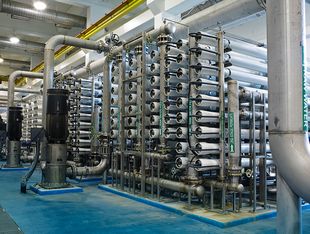
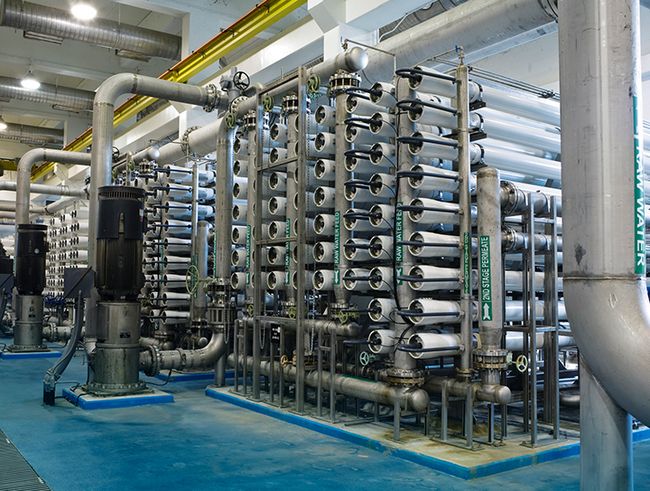
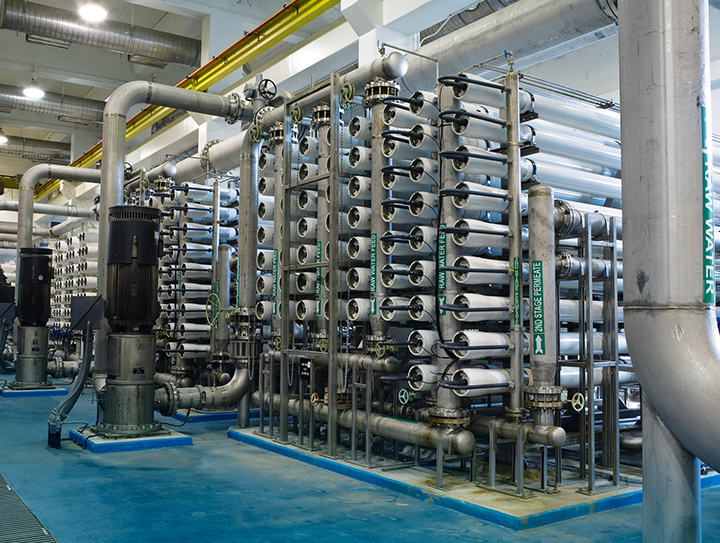

In addition to its own production of green hydrogen, Germany's National Hydrogen Strategy also envisages its import - primarily from North and West Africa, where it can be produced at very low cost from solar and wind power. In 2020, Federal Research Minister Anja Karliczek and her then Nigerian counterpart Yahouza Sadissou agreed on a package of measures to expand the partnership with West Africa. One of the challenges associated with importing hydrogen is to provide sufficient fresh water for water electrolysis without exacerbating local water scarcity. Seawater desalination technologies make a crucial contribution to protecting the environment in the respective countries.
In seawater desalination plants, water is processed for electrolysis. The long-term development of appropriate infrastructures for seawater desalination goes hand in hand with considerable benefits for society as a whole in the producing regions and offers great potential for economic cooperation and development aid.
But how does a desalination plant work? The established processes for desalinating seawater are divided into thermal distillation processes and membrane-based pressure filtration processes. The two operating modes of seawater desalination plants are described below.
Thermal distillation in a seawater desalination plant
- MED – Multi-effect distillation
- MSF – Multi-stage flash distillation
- TVC – Thermo vapour compression
Thermal distillation in desalination plants is characterized by high energy input: In thermal processes, the water extracted from the sea by a pump is passed through condensation stages in a seawater desalination plant. Heat from power plants in the gas and oil industry, but also from nuclear reactors, is mostly used to heat the water to over 100° C. For every 1,000 litres of water, about 100 kilowatt-hours of energy are needed.
Especially in the dry, sunny regions of North Africa and the Middle East, thermal processes used in seawater desalination plants have been making an important contribution to fresh water supply for many years. Today, they can be optimized through hybrid concepts and, for example, enable the transition to a sustainable energy economy in solar/fossil operation.
Seawater desalination plant with membrane-based pressure filtration
- RO – Reverse osmosis
- NF - Nanofiltration
- ED – Electrodialysis
This mode of operation in seawater desalination plants stands out due to efficient energy management: thanks to powerful high-pressure pumps that force seawater through special membranes, as well as efficient systems for energy recovery, reverse osmosis has become more and more established as the leading technology for seawater desalination. For every 1,000 litres of water, the most modern seawater desalination plants require only about 2.5 kilowatt-hours of energy.
In sun- and wind-rich coastal areas, seawater desalination in special plants by reverse osmosis also facilitates the economic production of green hydrogen. In order to maximize the efficiency of electrolysers, it is preferable to use sites that have high solar radiation during the day and wind energy at night. Alternatively, fuel cells can also serve as an energy supplier in times of low wind.
What colour is hydrogen?
Hydrogen is colourless and odourless. The frequently asked question "What colour is hydrogen?" therefore does not refer to a specific colour, but to the amount of carbon dioxide emissions generated directly or indirectly in the production of hydrogen.




Thus, the respective colour category can be used to identify whether the production of hydrogen is environmentally friendly. A distinction is made between green, blue, turquoise and grey hydrogen.
The individual colours of hydrogen are defined as follows:
Green hydrogen
Green hydrogen is produced with renewable energies (such as water and wind power or photovoltaics), primarily from water in an electrolysis process. In this process, the water molecule is split into the two elements hydrogen (H2) and oxygen (O2). Producing hydrogen sustainably: If only electricity from renewable energy sources is used in water electrolysis, then the hydrogen produced in this way is considered to be free of carbon dioxide and thus green hydrogen. However, even the production of a wind turbine, for example, is not completely climate-neutral. If you want to produce green hydrogen, you can also gasify and ferment biomass or reform biogas. When renewable energies are used in methanol synthesis, i.e. the conversion of hydrogen and carbon dioxide (e.g. from industrial processes) into methanol, the result is actually considered "green methanol".
Blue hydrogen
Blue hydrogen is produced by fossil fuels, so it is basically grey hydrogen. However, there is a crucial difference with blue hydrogen: unlike grey hydrogen, carbon dioxide does not enter the atmosphere. Instead, the carbon dioxide is separated, captured and injected, for example, into suitable geological formations deep underground. Therefore, blue hydrogen is considered carbon dioxide-neutral in the balance. The corresponding process is called "carbon capture and storage" (CCS). Potential storage sites are former oil or gas reservoirs and rock strata containing salt water. So far, this process for the production of blue hydrogen has only been used in pilot and test projects in Germany.
Turquoise hydrogen
When hydrogen is produced via the thermal cracking of methane or natural gas (some natural gases consist of 98 % methane), it is turquoise hydrogen. This process, known as "methane pyrolysis", produces solid carbon instead of carbon dioxide. If the high-temperature reactor is operated with renewable energy sources and the carbon is permanently bound, this process is carbon dioxide neutral. A decisive advantage is that carbon can be stored more easily than carbon dioxide and can be used, for example, in the chemical and electronics industries or in road construction. Compared to the production of green hydrogen by electrolysis, methane pyrolysis is said to require only a fifth of the energy in the production of turquoise hydrogen. However, this process for hydrogen production has so far only been tested on a laboratory scale.
Grey hydrogen
Currently, grey hydrogen still dominates the German market. It is produced from fossil fuels, primarily natural gas and coal. In the production of hydrogen through steam reforming, for example, natural gas is converted into hydrogen and carbon dioxide at temperatures of up to 1,000 °C. Depending on the source and the electricity mix, around 10 tonnes of carbon dioxide are produced during the production of one tonne of hydrogen. Since it escapes unused into the atmosphere and is not stored in any form, grey hydrogen thus reinforces the greenhouse effect.
